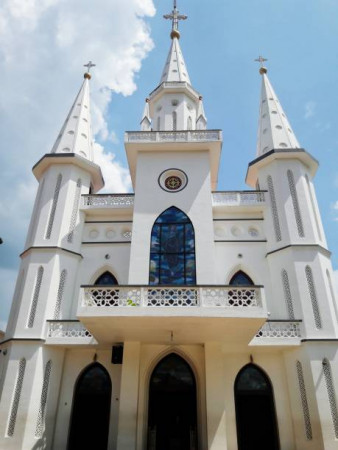
Pathanamthitta
Package
1000 to 10000
1000 to 10000
Duration
2 to 4 Days
2 to 4 Days
Best time to visit
Sep-Feb
Sep-Feb
Theme
Hill Station, Religious, Wildlife
Hill Station, Religious, Wildlife
Pathanamthitta Travel Guide
Pathanamthitta, located in the southern part of India's Kerala state, is a region known for its rich cultural heritage, captivating landscapes, and vibrant traditions. This picturesque destination is famous for its historical significance, being home to ancient temples, serene rivers, and lush greenery. Pathanamthitta is also known for its religious festivals and traditional art forms, making it a must-visit for culture enthusiasts and nature lovers alike.Top Attractions in Pathanamthitta
- Sabarimala Temple
- Perunthenaruvi Waterfall
- Konni Elephant Training Center
- Adavi Eco Tourism
- Pamba River
Pathanamthitta is Famous for
Its renowned Sabarimala Temple pilgrimage and mesmerizing natural beauty.Top Attractions in Pathanamthitta
- Sabarimala Temple
- Perunthenaruvi Waterfall
- Konni Elephant Training Center
- Adavi Eco Tourism
- Pamba River
What's Great about Travelling to Pathanamthitta?
- Experience the unique culture and traditions of Kerala
- Explore pristine natural beauty
- Participate in religious festivals and rituals
What's Not So Great about Travelling to Pathanamthitta?
- Limited nightlife options
- Monsoon season can be quite rainy
- May be crowded during peak pilgrimage seasons
Travel Tips for Pathanamthitta
- Observe and respect local customs and traditions
- Carry sufficient cash as ATMs may not be easily accessible in remote areas
- Stay hydrated and use sunscreen to protect against the tropical sun
Important Pathanamthitta trip information
- Ideal Duration: 3-5 days
- Best Time to Visit: November to February
- Nearby Airports and Railway Stations: Cochin International Airport, Thiruvananthapuram International Airport; Chengannur Railway Station, Thiruvalla Railway Station
Top 13 Places to visit in Pathanamthitta
FAQ's on Pathanamthitta
Q1: What is the best time to visit Pathanamthitta?
The best time to visit Pathanamthitta is during the winter months from November to February when the weather is pleasant and ideal for exploring the outdoors. This period also coincides with festivals like Sabarimala pilgrimage and the Pamba Boat Race, offering a cultural experience. Avoid the monsoon season from June to September due to heavy rainfall which may disrupt travel plans.
Q2: Do I need a visa to travel to Pathanamthitta?
Most tourists traveling to Pathanamthitta will require a tourist visa. Ensure your passport has a validity of at least six months from the date of arrival. Certain nationalities may be eligible for visa on arrival or e-visa, so check with the Indian embassy for specific requirements.
Q3: What are the must-visit attractions in Pathanamthitta?
Pathanamthitta offers a unique blend of natural beauty and cultural heritage. Must-visit attractions include the Sabarimala Temple, Perunthenaruvi Waterfall, Konni Elephant Training Center, and the Aranmula Parthasarathy Temple. Explore the lush forests of the Western Ghats or take a houseboat ride on the serene backwaters of the Pamba River for a memorable experience.
Q4: Is Pathanamthitta a safe place to travel?
Pathanamthitta is generally a safe destination for travelers. However, it's advisable to take usual precautions like avoiding isolated areas at night and safeguarding your belongings. Respect local customs and traditions to ensure a pleasant and hassle-free trip.
Q5: What is the local currency in Pathanamthitta and can I use credit cards?
The local currency in Pathanamthitta is the Indian Rupee (INR). ATMs are widely available in urban areas, but it's recommended to carry cash for transactions in rural areas. Credit cards are accepted in major establishments, but smaller shops and vendors may prefer cash payments.
Q6: What is the local cuisine like in Pathanamthitta?
Pathanamthitta offers a diverse culinary experience with a mix of traditional Kerala cuisine. Don't miss trying dishes like Puttu and Kadala curry, Karimeen Pollichathu (fish), and Appam with Stew. Vegetarians can savor dishes like Avial and Thoran. Be prepared for spicy flavors and coconut-based curries that are characteristic of Kerala cuisine.
Q7: What transportation options are available in Pathanamthitta?
Pathanamthitta has a well-connected transport system with options like buses, auto-rickshaws, and taxis for local travel. Renting a car or bike is also a convenient way to explore the region. Public buses are economical for intercity travel, while taxis provide a more comfortable option for longer journeys.
Q8: Are there any cultural norms or etiquette I should be aware of when visiting Pathanamthitta?
When visiting Pathanamthitta, it's important to respect local customs and traditions. Dress modestly, especially when visiting religious sites. Remove footwear before entering temples and follow any specific guidelines or rituals. Asking for permission before taking photographs of locals is considered polite. Greet people with a smile and a respectful "Namaste" as a common form of greeting.
Q9: I am a travel agent. How can I buy travel leads of Pathanamthitta?
Register yourself as a travel agent at agents.tripclap.com and then you can buy travel leads to Pathanamthitta once your account is approved. For more details contact our support team at +91-8069186564 or support@tripclap.com
